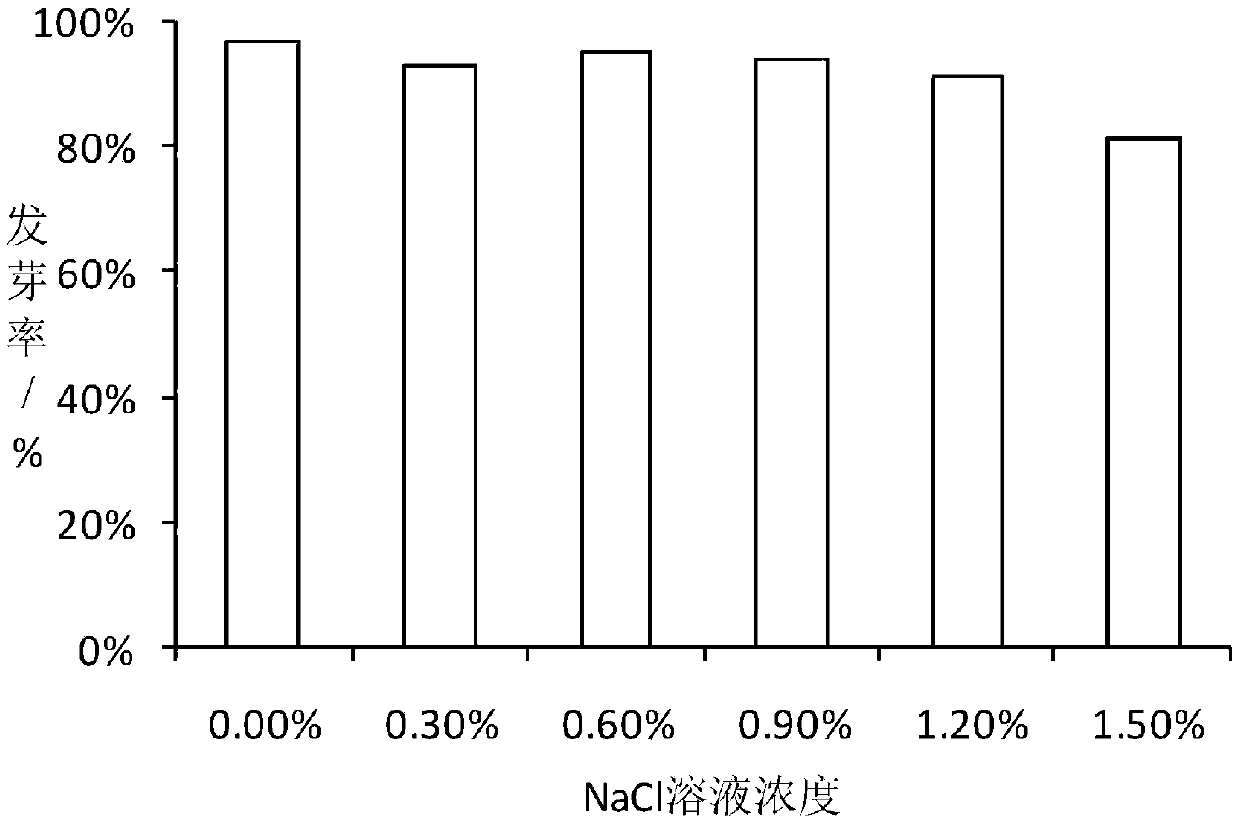Method for breaking hard seeds of alhagi sparsifolia and determining salt tolerance of hard seeds during germination
A technology of salt tolerance and germination period, which is applied in the field of camel thorn hard seed removal and the determination of salt tolerance during germination period, can solve the problems of prolonging the emergence time, hindering the germination of seeds, increasing the number of irrigations, etc. Operability, cost reduction effect
- Summary
- Abstract
- Description
- Claims
- Application Information
AI Technical Summary
Problems solved by technology
Method used
Image
Examples
Embodiment 1
[0023] Manually collect the camel thorn fruit, put it into a woven bag and take it to the botanical garden for drying in the shade, turn it 2-3 times a day, after the fruit is fully dry, beat the camel thorn fruit with an elastic stick, and after more than 90% of the seeds fall off, use a dustpan Screen out large and small impurities, pour the remaining seeds and similar impurities into the water, the seeds with full grains sink into the water, and the impurities and damaged seeds flow out with the water. After several times of water selection, the obtained seeds are placed in cement The ground can be dried and bagged for storage. Before the test, soak the tested seeds in a 500mL beaker with distilled water, put them in a constant temperature incubator at 25°C, change the water 2 to 3 times a day, and remove the seeds with broken seed coats or poorly imbibed seeds in time until they grow again. The hard seeds were dried naturally in the laboratory until there was no seed imbib...
example 2
[0028] Before the experiment, soak the tested seeds in a 500mL beaker with distilled water, place them in a constant temperature incubator at 25°C, change the water twice a day, and pick out the seeds with cracked seed coats or poorly imbibed seeds in time until there are no more seeds The hard seeds were dried naturally in the laboratory until imbibition. Select robust, plump, non-damaged and pest-free camel spines as experimental materials, sterilize them with 0.5% potassium permanganate solution for 5 minutes, then rinse them with distilled water and dry them for later use; the prepared concentration is 0.1g / ml~0.2 g / ml of gibberellin GA3, the sterilized camel thorn seeds were soaked with gibberellin GA3 for 24h under total darkness; then the camel thorn seeds were placed in a petri dish covered with 2 layers of filter paper, distilled water was added, and placed Germination was carried out in an incubator in complete darkness at 25°C. After 10 days of germination observat...
example 3
[0030]Before the test, soak the tested seeds in a 500mL beaker with distilled water, place them in a constant temperature incubator at 25°C, change the water twice a day, and remove the seeds with cracked seed coats or poorly imbibed seeds in time until there are no more seeds Until imbibition, dry the hard seeds naturally in the laboratory, put the dry hard seeds in a beaker, then slowly pour 98% concentrated sulfuric acid, the weight ratio of concentrated sulfuric acid to seeds is 6:1, rinse with tap water after 10 minutes of treatment 4 to 5 times, rinse with distilled water 3 times and set aside. Choose a petri dish with a caliber of 100mm, first wash the petri dish with tap water twice, then wash it with distilled water for three times, then dry it in an oven at 80°C for 2 hours, spread two layers of filter paper in the petri dish, each petri dish Put into 50 seeds of the concentrated sulfuric acid treatment of step S3, then add the NaCl solution of 6 concentrations of eq...
PUM
 Login to View More
Login to View More Abstract
Description
Claims
Application Information
 Login to View More
Login to View More - R&D
- Intellectual Property
- Life Sciences
- Materials
- Tech Scout
- Unparalleled Data Quality
- Higher Quality Content
- 60% Fewer Hallucinations
Browse by: Latest US Patents, China's latest patents, Technical Efficacy Thesaurus, Application Domain, Technology Topic, Popular Technical Reports.
© 2025 PatSnap. All rights reserved.Legal|Privacy policy|Modern Slavery Act Transparency Statement|Sitemap|About US| Contact US: help@patsnap.com



